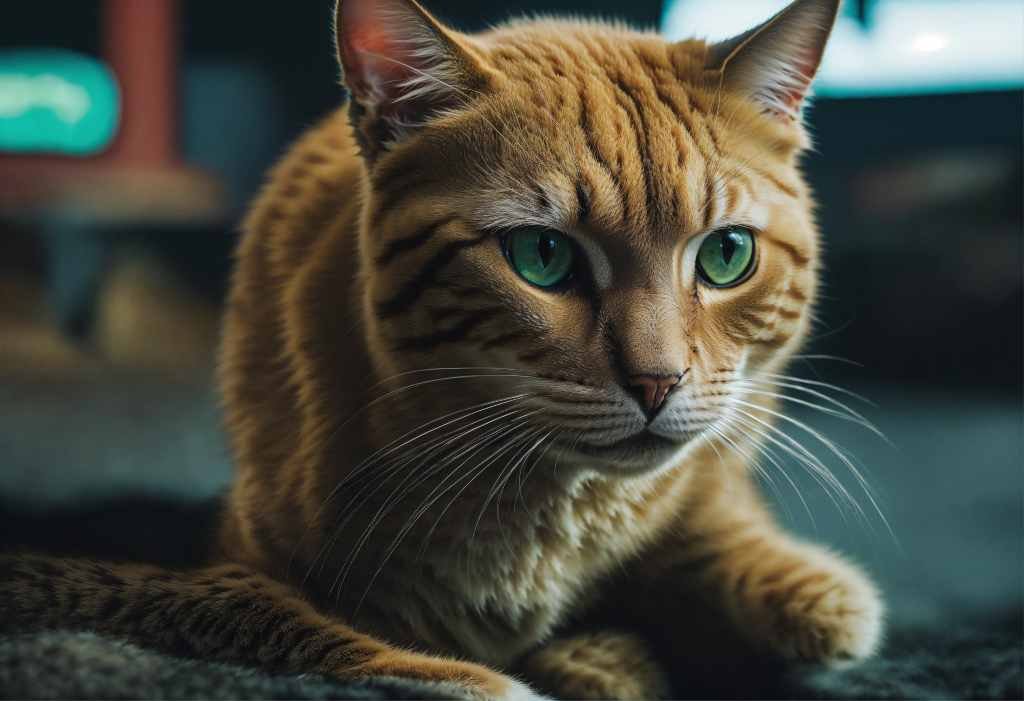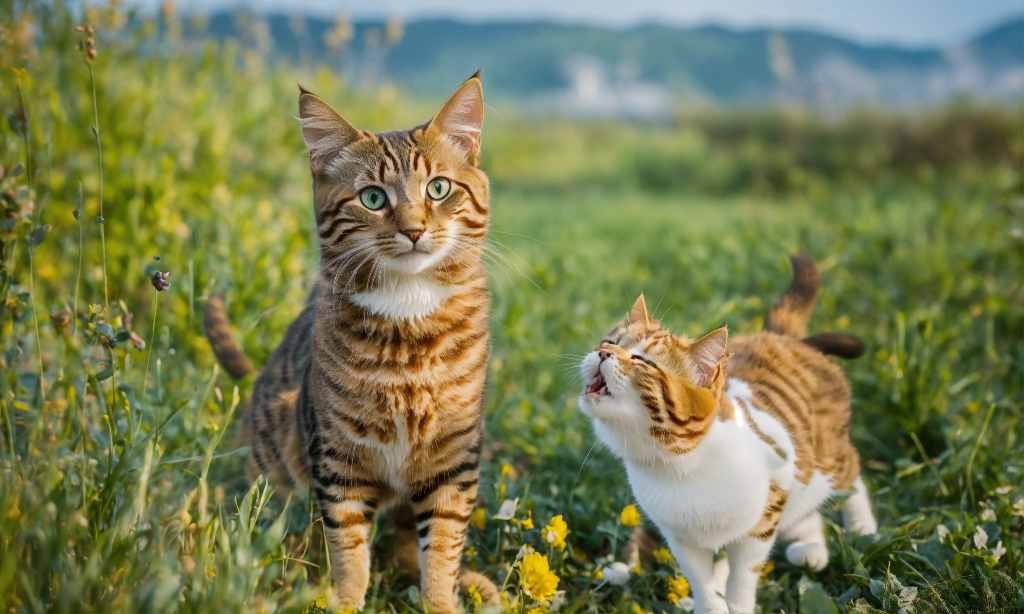This content aims to provide an in-depth exploration of curious cats, their behavior, instincts, intelligence, and the importance of ensuring their safety while they satisfy their natural curiosity.
Curious cats are remarkably observant, finely tuned to detect even the slightest environmental movements. Their acute senses, evolved from their hunting ancestry, allow them to survey their surroundings precisely.
Exploration: A Key Aspect of Feline Behavior

- Cats have an innate desire to explore their surroundings, driven by their inherent curiosity.
- They engage in various exploratory activities, such as:
- Climbing on high surfaces like bookshelves to survey their territory
- Investigating new objects or spaces, like paper bags or boxes
- Every new corner or object presents an opportunity for a curious cat to embark on a thrilling adventure.
Fascination with curious cats
- Cats’ relentless curiosity and fearless exploration often captivate and inspire people.
- Their ability to pursue knowledge and approach the unknown with unwavering determination is admirable.
- Whether a cat is perched on a high vantage point, observing its surroundings, or embarking on a daring expedition to discover new territories, their curiosity fascinates those who observe them.
Mischievous side of curious cats
- Curious cats often display a mischievous streak as they explore their environment.
- They may engage in playful but destructive behaviors, such as:
- Knocking over ornaments or other objects
- Unraveling toilet paper rolls or other household items
- While these mischievous acts can be frustrating for owners, they also serve as a reminder of the cat’s irrepressible spirit and playful nature.
- The mischief caused by curious cats often endears them to their human companions, who appreciate their lively and entertaining personalities.
Nosiness: A trait of curious cats
- Curious cats are unabashedly nosy, constantly poking their whiskered noses into every nook and cranny they encounter.
- They are determined to uncover hidden secrets and investigate every aspect of their environment.
- Examples of their nosiness include:
- Investigating a forgotten closet or rarely accessed room
- Peering over the edge of a table or counter to see what lies beneath
- Sniffing and exploring new objects brought into the home
- A curious cat’s nosiness knows no bounds, as they are driven by an insatiable desire to understand and explore their world.
Cat Instincts and History
Genetic instincts of curious cats
- Primal instincts that govern feline behavior are deeply embedded within the genetic code of every cat.
- These instincts have been honed through millions of years of evolution, shaping cats into the curious and adaptive creatures they are today.
- Examples of genetically ingrained instincts include:
- Hunting techniques, such as stalking, pouncing, and using their sharp claws and teeth to catch prey
- Social interactions, like rubbing against objects or people to mark their scent and establish familiarity
- These instincts are crucial to a cat’s survival and overall well-being, influencing their behavior and decision-making processes.
Territorial instincts in feline behavior
- Cats are well-known for their territorial, solid nature, fiercely defending their designated space from intruders.
- This territorial instinct is deeply ingrained in their behavior and is closely linked to their curious nature.
- As cats explore their environment, they simultaneously mark their territory through various means, such as:
- Rubbing their scent glands (located on their cheeks, paws, and tail) against objects
- Scratching surfaces leave visual and olfactory marks.
- Urine spraying to establish boundaries.
- The territorial aspect of feline behavior showcases their intelligence and curiosity as they actively investigate and protect their living space.
Hunting: A display of cat intelligence and instincts
- The primal instinct to hunt is a fundamental aspect of a cat’s nature, even in domestic settings.
- Cats retain their keen hunting skills, refined through generations of wild ancestors.
- When engaging in play with toys, cats often exhibit hunting behaviors, such as:
- Stalking their “prey” (i.e., toys) with careful, calculated movements
- Pouncing on the toy with precision and agility
- Using their sharp claws and teeth to “capture” and “kill” the toy
- This display of hunting behavior highlights the intelligence of cats, as they employ complex strategies and problem-solving skills to successfully “hunt” their toys.
- The persistence and dedication cats show in honing their hunting skills demonstrate their inherent curiosity and desire to learn and adapt.
- The hunting instinct is a crucial aspect of what makes cats fascinating to observe and interact with, as it showcases their natural abilities and curious nature.
Cat Intelligence and Curiosity

Brain and Cognition: The Science Behind Cat Intelligence
Cats are brilliant creatures with complex cognitive abilities. From problem-solving to memory retention, they navigate their environment with grace and agility.
Sensory Systems: A Testament to Cat Intelligence
A cat’s intelligence is underscored by its remarkable sensory systems. Acute hearing, keen sense of smell, and sharp eyesight allow them to perceive the world in ways humans can only imagine.
Play and Exploration: Signs of Cat Intelligence
Play provides cats with mental stimulation and enrichment. Their natural curiosity drives them to explore new toys and activities, honing their cognitive skills.
Expressions of Cat Curiosity
Play: A display of curious cats
- Play is one of the most evident expressions of a cat’s curiosity and is an essential aspect of their physical and mental well-being.
- Playing allows cats to exercise their instincts, such as hunting and exploring, in a safe and controlled environment.
- Everyday play activities that showcase a cat’s curiosity include:
- Batting at feather toys or other dangling objects
- Chasing laser pointers or moving toys across the floor
- Pouncing on and wrestling with stuffed animals or other interactive toys
- Play keeps cats physically fit and provides mental stimulation, preventing boredom and promoting happiness and overall health.
Hideaways: Curious cats’ favorite spots
- Cats naturally seek out cozy, secure spaces to observe their surroundings while feeling protected.
- These hideaways satisfy a cat’s curiosity by providing a vantage point from which they can watch the world go by without being disturbed.
- Some favorite hideaway spots for curious cats include:
- Sun-drenched window sills, where they can bask in warmth while observing outdoor activities
- Snug cardboard boxes or other enclosed spaces that offer a sense of security and comfort
- Perches atop high furniture, such as bookshelves or cat trees, which allow them to survey their domain
- Cats can indulge their curiosity by seeking out these hideaways while maintaining a sense of safety and control over their environment.
Attention-seeking: A common trait in curious cats
- Curious cats often crave attention and affection from their human companions, as they are inherently social creatures.
- They may seek out interactions with their owners to satisfy their curiosity and forge deeper bonds.
- Common attention-seeking behaviors in curious cats include:
- Rubbing against their owner’s legs or hands to solicit petting and affection
- Meowing or vocalizing to get their owner’s attention and encourage interaction
- Following their owner from room to room to maintain proximity and observe their actions
- C curious cats demonstrate their desire for companionship and interest in their human family members by engaging in these attention-seeking behaviors.
Hunger: How it Drives Curious Cats
- Hunger is a powerful motivator for cats, driving them to explore their surroundings for food and satisfying their natural foraging instincts.
- Even well-fed domestic cats may exhibit curious behaviors related to hunger, as the instinct to hunt and gather food is deeply ingrained in their nature.
- When hungry, curious cats may:
- Investigate every nook and cranny of their home, searching for potential food sources or hiding spots.
- Show increased interest in their owner’s food or attempt to steal tidbits from plates or counters.
- Become more vocal, meowing, or yowling to communicate their desire for food.
- The drive to satisfy their hunger encourages cats to be more curious and exploratory as they actively seek sustenance and engage their natural hunting instincts.
Ensuring Safety for Curious Cats

Household Hazards for Curious Cats
To keep curious cats safe, eliminate or mitigate potential hazards like toxic plants and small objects they may ingest or come into contact with accidentally.
Blind cord safety for curious cats
- Blind cords pose a significant risk to curious cats, as they can quickly become entangled or strangled while playing or exploring.
- To ensure the safety of curious cats, it is essential to:
- Secure blind cords out of reach by tucking them away or using cord cleats to keep them taut and away from prying paws.
- Consider investing in cordless blinds or shades, eliminating the risk of entanglement.
- These precautions allow cat owners to create a safer environment for their curious felines, preventing potentially life-threatening accidents.
Electric cord safety for curious cats
- Electric cords and outlets can be tempting targets for curious cats who may chew on or play with them, leading to electrical shocks or injuries.
- To protect curious cats from electrical hazards, cat owners should:
- Cover exposed electric cords with cord protectors or conceal them behind furniture to prevent access.
- Use cord shorteners or organizers to keep excess cord length tucked away and out of reach.
- Install outlet covers or safety plugs to prevent cats from inserting their claws or tongues into sockets.
- Cat owners can minimize the risk of their curious cats suffering from electrical shocks or burns by securing electric cords and outlets.
Mothball safety for curious cats
- Mothballs contain toxic chemicals, such as naphthalene or paradichlorobenzene, which can harm curious cats if ingested or inhaled.
- To keep curious cats safe from mothball toxicity, cat owners should:
- Store mothballs securely out of reach, such as in a locked cabinet or closet.
- Avoid using mothballs in areas frequented by cats, such as bedrooms, living rooms, or other shared spaces
- Consider using alternative, non-toxic moth repellents like cedar chips or lavender sachets.
- By minimizing mothball exposure and opting for safer alternatives, cat owners can protect their curious cats from potentially harmful chemicals.
Garage chemical safety for curious cats
- Garages often contain various hazardous chemicals, such as antifreeze, oil, and cleaning products, which can be deadly to curious cats if ingested or come into contact with their skin or fur.
- To ensure the safety of curious cats in the garage, cat owners should:
- Store all hazardous chemicals securely in sealed, leak-proof containers out of reach of cats
- Keep the garage door closed and limit access to the area to prevent unsupervised exploration.
- Clean up any spills or leaks immediately and thoroughly to avoid accidental exposure.
- Consider using pet-safe alternatives to harsh chemicals whenever possible.
- By properly storing and handling dangerous chemicals in the garage, cat owners can create a safer environment for their curious felines, reducing the risk of accidental poisoning or injury.
Conclusion
Curious cats are a delightful blend of intelligence, curiosity, and mischief. Their insatiable thirst for knowledge enriches our lives, but it’s crucial to ensure their safety as they explore the world around them. Understanding their behavior, instincts, and needs creates a safe environment where they can thrive and captivate us with their curious antics.
